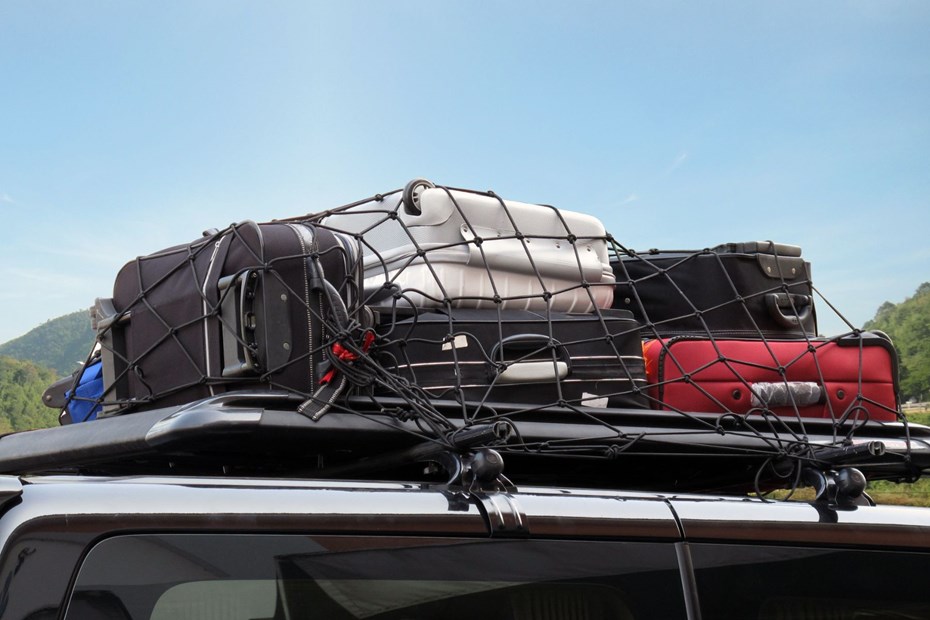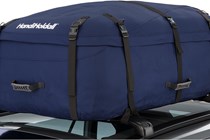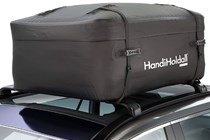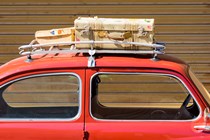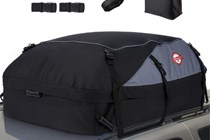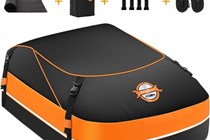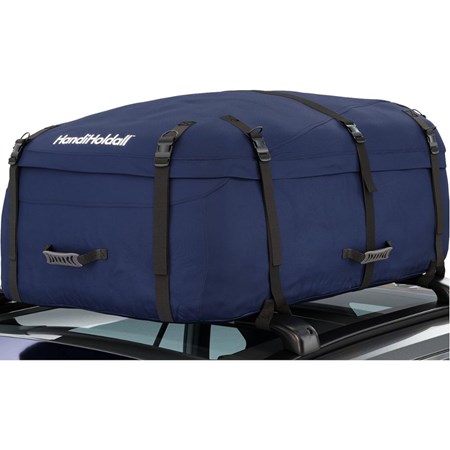When you picture car roof bags, you might either imagine a chic old classic car with suitcases strapped to a roof rack or the modern alternative consisting of a heavy-duty fabric bag designed specifically for that purpose. The ability to extend your car’s cargo capacity can be achieved in several ways. This can be in the form of a bike rack; it could also be in the form of a roof box or roof bag. Purely in terms of value, roof bags look like a very tempting alternative to roof boxes. But the question is, are they worth the saving? Parkers take a look at car roof bags.
Because of the lack of aerodynamics and noise generated as a result, we suggest roof bags for those who are undertaking a trip without motorways over long distances. For long-haul or continental road trips, a sleeker roof box would be better suited.
A roof bag is a good option to consider if perhaps you’re heading away into the Scottish Highlands or somewhere where you’ll be driving at lower speeds, where the roof bag’s aerodynamic flaws don’t matter quite so much. They’re also a very useful addition if you’re already carrying a bike rack or a converted campervan to give you extra storage space.
The best car roof bags at a glance:
Editor’s pick: Fischer 126000 Roof Bag – Buy from Amazon
Best car roof bag for capacity: Rightline Gear Range 3 – Buy from Amazon
Best car roof bag on a budget: Salinovo Roof Bag – Buy from Amazon
We will be listing the best roof bags that are on sale. We’ll also be discussing which ones are best suited to what kinds of vehicles. We’ll also be weighing up the pros and cons when comparing them to roof boxes, as well as how you can protect and install them.
The best car roof bags
Editor's pick
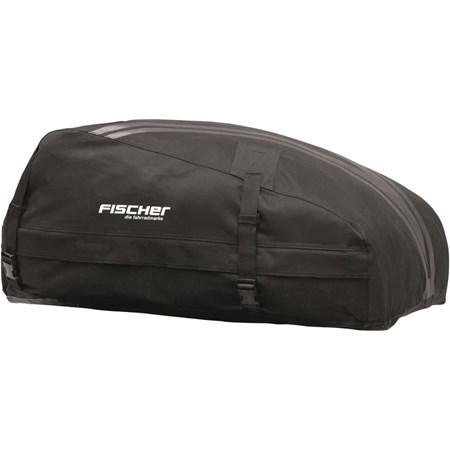

The underside has metal railings that both strengthen the bag and allow for an excellent fixing mechanism, where you screw in brackets underneath the bag that fasten it to the roof racks.
Pros
- Great quality and design
- Sits above car roof
Cons
- Not a massive volume
| Volume: | 270 litres |
| Dimensions: | 100cm (L) x 80cm (W) x 40cm (H) |
| Max load capacity: | 50kg |
| Weight: | 5.5kg |
| Needs roof rails? | Yes |
Pros
- Sits above the car roof
- Rigid base
Cons
- Not as aerodynamic as Fischer 126000
| Volume: | 330 litres |
| Dimensions: | 110cm (L) x 75cm (W) x 40cm (H) |
| Max load capacity: | 50kg |
| Weight: | 3.6kg |
| Needs roof rails? | Yes |
Best car roof bag for capacity
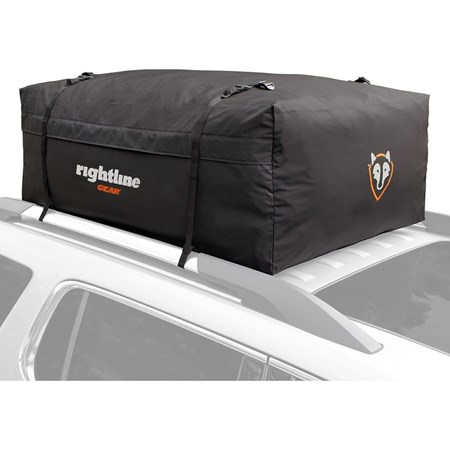

However, in addition to capacious volume, another plus point with this roof bag is that it can be used without a roof rack if you wish. But the downside of the Range 3's design is that it sits directly on the roof regardless of whether you use roof racks or not. It's tit-for-tat here with design versus volume, so it depends very much on your specific needs.
Pros
- Huge volume
- Well made
Cons
- Not aerodynamic at all
| Volume: | 509 litres |
| Dimensions: | 122cm (L) x 91cm (W) x 46cm (H) |
| Max load capacity: | Not given |
| Weight: | 3.7kg |
| Needs roof rails? | No |
Best for smaller cars
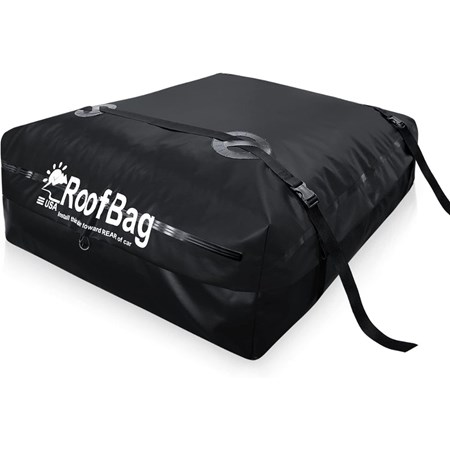

Pros
- Size suitable for a range of vehicles
- Highly durable
Cons
- Sits directly on the car roof
| Volume: | 311 litres |
| Dimensions: | 102cm (L) x 94cm (W) x 43cm (H) |
| Max load capacity: | Not given |
| Weight: | 3.6kg |
| Needs roof rails? | No |
Best car roof bag on a budget
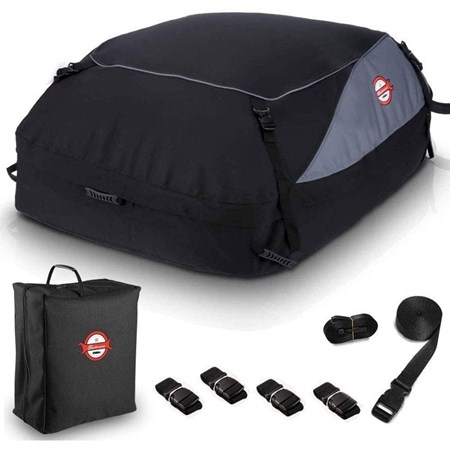

The 600D nylon fabric is waterproof and reasonably durable but you don't get that same level of build quality as seen on the other bags above.
Pros
- Good value
- Large volume
Cons
- Build quality inferior to competitors
| Volume: | 425 litres |
| Dimensions: | 105cm (L) x 90cm (W) x 45cm (H) |
| Max load capacity: | Not given |
| Weight: | 2.7kg |
| Needs roof rails? | No |
Best roof bag UV protectant spray
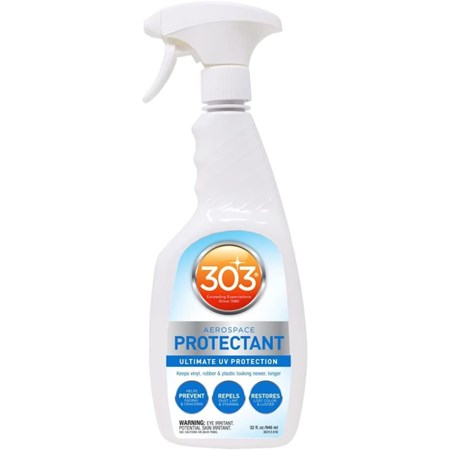

We recommend 303 Aerospace Protectant. It’s a water-based solution so it can be used on such a vast array of materials, and it is a very effective UV protectant.
Pros
- Effective UV ray blocker
- Prevents fading and cracking
Cons
- Amount in bottle is easy to chew through
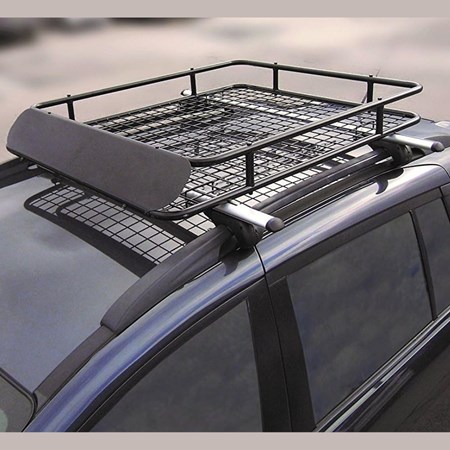

Pros
- Useful for keeping bags off the roof of your car
- Answer for bags without rigid base
Cons
- Won't fit the larger bags
Roof weight limits
It’s very important you do not exceed your car’s roof load limit. Check your car’s handbook to find out what this is. Remember, to calculate the total payload that will be on the roof, you need to add the weight of the roof racks (if using), roof bag, and payload together. And remember to always follow the fitting instructions as provided by the manufacturer and not to drive with empty roof bags fitted to car roofs. It’s all in the habit of checking before buying, like for example, knowing what dimensions your vehicle is before buying a protective cover for it.
Pros and cons
The advantages are that they represent value for money over their roof box counterparts. They’re generally less expensive and this will suit a lot of people looking for extra storage. If you travel around with a pet, and may require a pet car seat cover, you will need a bit of leeway for luggage space. Also like roof boxes, they come in a range of shapes and sizes that will be better suited to certain vehicles over others. The largest roof bags can be had in 500-litre form, and while some boxes can surpass 600, that’s still impressive. What’s also impressive is that they’re made from heavy-duty waterproof and UV-resistant fabrics. Those made by good manufacturers will last a while, even with all-round harsh weather conditions.
However, there are some drawbacks to consider too. They are not as accessible as roof boxes once fitted and filled. Roof boxes open easily from one or both sides, whereas roof bags need to be unclipped and unzipped. Boxes are much more aerodynamic too, and therefore don’t have as much of a detrimental effect on fuel economy. Roof bags also create more wind noise at speed that not even the best wind deflectors could cure. Lastly, some sit directly onto the roof of a vehicle. We recommend you avoid this either by buying one that is designed to fit roof racks or use in conjunction with a tray. The issue with the latter is that it reduces the value for money aspect. At the very least, buy a non-slip protective mat to go between the roof bag and roof.
Aaron Hussain is a commercial content writer at Bauer Media writing for Parkers and CAR. He is obsessed with classic cars and anything with a fascinating story to tell.
Sign up to the Parkers Newsletter to keep up to date with more of the latest reviews, news, and recommendations from the Parkers team.
Just so you know, whilst we may receive a commission or other compensation from the links on this page, we never allow this to influence product selections – read why you should trust us.



